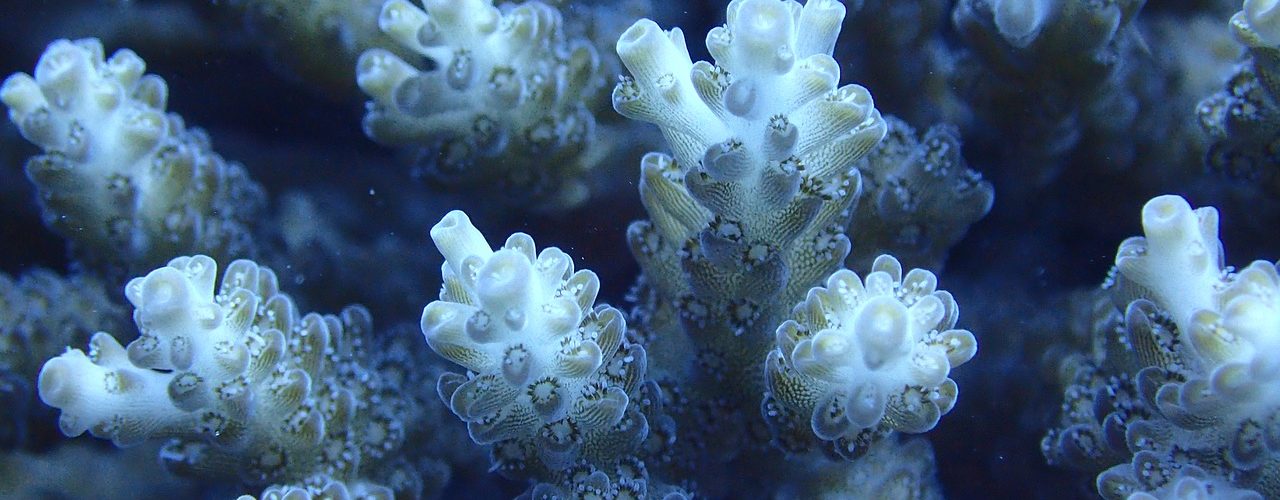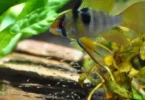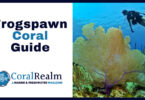Last Updated on February 10, 2023 by Matt
SPS coral is a generic term given to a group of hard corals with small polyps. SPS stands for small polyp stony, and with the LPS corals (Large Polyp Stony) they make the hard corals.
IN THIS ARTICLE
SPS Coral General Information
Hard corals are the backbone of coral reefs. They produce an exoskeleton composed of calcium carbonate, which as the corals grow become the foundations of new growth, forming the reef itself, and increasing the size of the coral reef ecosystem. Soft corals such as pulsing xenia don’t possess a large exoskeleton and so don’t contribute to the growth of the reef shelf.
The grouping of hard coral species into SPS and LPS groups isn’t based on taxonomy or evolutionary factors. It is instead based purely on the size of the living coral polyp. SPS corals have small polyps of around a few millimeters or less, while LPS corals have much larger polyps.
All coral species are marine sessile benthic invertebrates. Each coral colony is composed of a myriad of genetically identical polyps, and they grow by asexual reproduction. Corals also reproduce sexually by spawning, with members of the same species releasing eggs and sperm simultaneously, often overnight at a full moon. Fertilized eggs form mobile larval corals called planulae, which mature and settle on an appropriate part of the reef.
All corals have tentacles covered with stinging cells called cnidocytes. Using these tentacles corals are able to catch passing prey such as planktonic organisms and even small fish. However most corals gain the majority of their energy through a symbiotic relationship with a class of dinoflagellate algae, zooxanthellae of the genus Symbiodinium. Other cnidarian groups such as sea anemones also have a symbiotic relationship with these algae. Zooxanthellae symbionts can make up as much as 30% of the tissue in a coral polyp.
SPS Coral Care
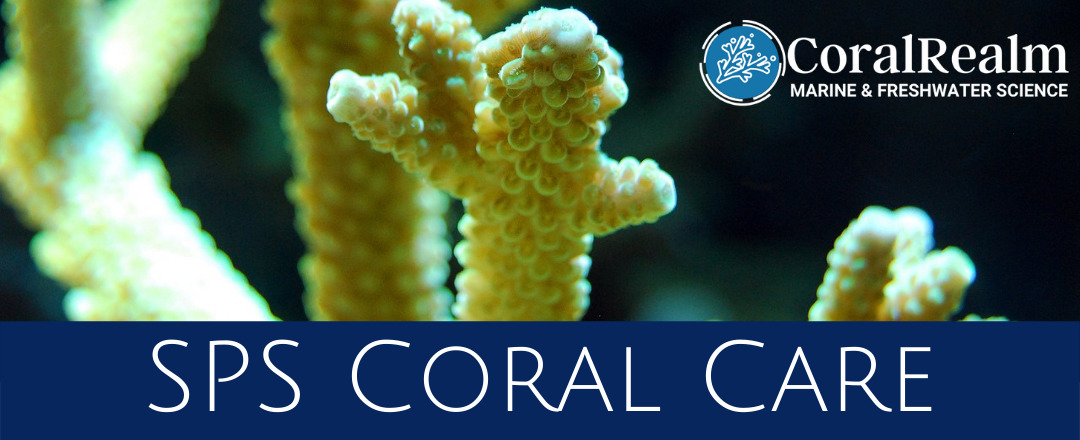
In general SPS corals are more difficult to care for in a reef aquarium system than their LPS counterparts. This could be due to a number of reasons, such as requiring higher light intensity, needing to be fed much smaller prey items, and needing a greater flow rate. Whatever the specific reason, SPS corals are in general less tolerant of environmental fluctuations, and can easily die.
As SPS coral are grouped because of polyp size, not any scientific or taxonomic reason, the best that can be given are generalized care guidelines for keeping these corals in the reef aquarium. Remember to always find out what specific care you need to give SPS coral species because trying to keep them successfully.
The video below gives some great tips on SPS coral care:
Lighting
Proper lighting is very important to successfully keeping SPS corals in a reef tank. Setting up the tank properly is key is keeping them healthy. SPS corals gain a significant amount of the energy they require from their zooxanthellae symbionts. These unicellular algae are found in their tissue, and utilize light for photosynthesis. There are many byproducts which the zooxanthellae don’t use, which go straight to their coral hosts.
Without the proper lighting SPS corals simply won’t survive in your tank. SPS corals need quite intense lighting, much more than LPS corals require. It is also important to understand that it isn’t simply light they need, it is the right kind of light.
Corals need light in the correct spectrum in order to properly fuel the photosynthetic process. If you want to have a tank with SPS corals, good quality lighting is needed. There are a couple of different lighting types you can use to supply the lighting; metal halide, T5 fluorescent and LED. Which lighting type is more appropriate depends on your specific tank setup. While metal halide and T5 fluorescent bulbs are very bright and provide great PAR, we tend to prefer good quality LED lighting.
Not only will good LED lights provide high light intensity of the correct spectrum, but they will also provide a built-in timer which will enable you to set a 24 hour custom lighting cycle. Ideally SPS coral need 9-12 hours of light per day.
Feeding
As corals need string lighting to be able to fuel photosynthesis, it can be easy to forget that they are actually animals, not plants. Corals are invertebrates, and the polyps are individual animals which have tentacles and a mouth.
As such, along with adequate lighting SPS corals need to be fed as well.
As their polyps are very small, SPS corals need to be fed planktonic animals such as cyclops, brine shrimp, or other small zooplanktonic animals. Using a product such as reef roids can be very useful in getting the polyps to have a feeding response and ensuring they have the proper nutrition.
There are two different ways of feeding corals; target/spot feeding and blanket feeding.
Target feeding SPS coral involves using a long reef pipette to blow zooplankton over the coral polyps. Blanket feeding is simply adding zooplankton to the tank as a whole, and relying on the circulation and flow created by wave makers to draw the food over the polyp tentacles.
Water Parameters
Along with ensuring that corals have appropriate lighting and are fed regularly, it is vital to have the correct water parameters to maintain health. Maintaining these water parameters is a much simpler process if you use distilled or RODI water.
SPS corals produce a calcium carbonate exoskeleton to support the polyps, and as such need these nutrients kept in the appropriate concentration. Calcium and magnesium should be kept in a rough ratio of 1:3, with calcium at a concentration of 380- 500 ppm and magnesium at a concentration of 1300-1500 ppm. Together carbonate and bicarbonate ions form the water carbonate hardness, or alkalinity. The tank should be kept at a carbonate hardness of 10-12 dKH.
SPS corals are also very sensitive to temperature fluctuations. A stable temperature range of 75-78 degrees Fahrenheit should be maintained. To achieve this ensure that you have a good quality aquarium heater and thermometer. Also just as important in maintaining temperature is a strong wave maker. This will ensure that all the tank water is heated evenly, and that there are no hotspots formed.
Another very important parameter to keep an eye on is the pH of the water. SPS coral needs a slightly alkaline pH range of 7.8-8.4. Carbonate hardness and pH are linked, as the carbonate and bicarbonate ions which form carbonate hardness act as a buffer to pH, making it a lot more stable. This is why carbonate hardness is also called alkalinity. You may have heard about ocean acidification; the same can happen in your tank if the water becomes too acidic. When the pH drops in your tank it means that the carbonate hardness has lowered and that the calcium carbonate exoskeleton of the corals can actually dissolve.
While temperature, carbonate hardness, calcium, magnesium, and pH are the main water parameters to keep an eye on, the trace elements such as chromium, cobalt, copper, iron, and manganese are equally important.
To ensure that SPS coral maintains healthy growth in a fish tank environment phosphate and nitrate levels also need to be tested regularly. Both phosphate and nitrate inhibit coral’s ability to absorb calcium carbonate. As they use this for the formation of their exoskeleton this is a serious concern. Nitrate should be kept in the range of 2.5-10 ppm and phosphate in the range of 0.3-0.7 ppm. If you test high phosphate levels use an aquarium phosphate remover, while certain chemical filtration medias can remove nitrate. Ensuring low phosphate and nitrate levels will also ensure that ammonia and nitrite concentrations are also at 0, another important consideration.
Also vital in keeping nitrate and phosphate levels down is a strong current. Strong flows will pick up and circulate any detritus to be picked up by the filter, which will otherwise become a source of these compounds. Regularly cleaning the filter and protein skimmer, as well as the substrate is a must as well.
Properly Positioning SPS Coral
As we have mentioned in the section regarding the lighting requirements of SPS coral, these small polyp corals need much more intense lighting than their LPS counterparts. As such, they need to be placed near the top of a reef tank.
If you have a mixed species coral reef tank, with both LPS and SPS corals, then you should place the SPS coral near the top of the rock, and the LPS coral near to the base. This is a general rule, and things like if shade is created by rocky overhangs, or if coral is directly under the light or toward the edge of the tank will have an effect as well.
Generally SPS coral are less able to fight for their position on the reef. This is due to the small size of the individual polyps, and the subsequent shorter tentacles. Therefore to enable them to grow successfully in the tank don’t place any other coral species or sea anemones near them which will try and take over the position.
SPS corals can grow very fast, and can easily block ight getting to the base of the tank, or even the base of the colony. Always keep in mind what look you want in your finished tank, and what a fully grown SPS colony will look like, as this may influence not only where to place the coral, but what coral species to choose.
Examples of SPS Corals for Reef Tanks
The most commonly kept SPS coral species are those found with the “pora” genera, namely Acropora, Pocillopora, Seriatopora, and Montipora.
The corals in these genera are in general branching or plate corals, which can produce stunning results in a reef tank ecosystem.
Acropora and Montipora are quite closely related, being two genera in the family Acroporidae. The same is true of the genera Pocillopora and Seriatopora, both being in the family Pocilloporodae.
Acropora species are perhaps the most commonly seen in the aquarium trade, known as table, staghorn, or elkhorn coral depending on the species. They can grow quite quickly and the branching arms look stunning.
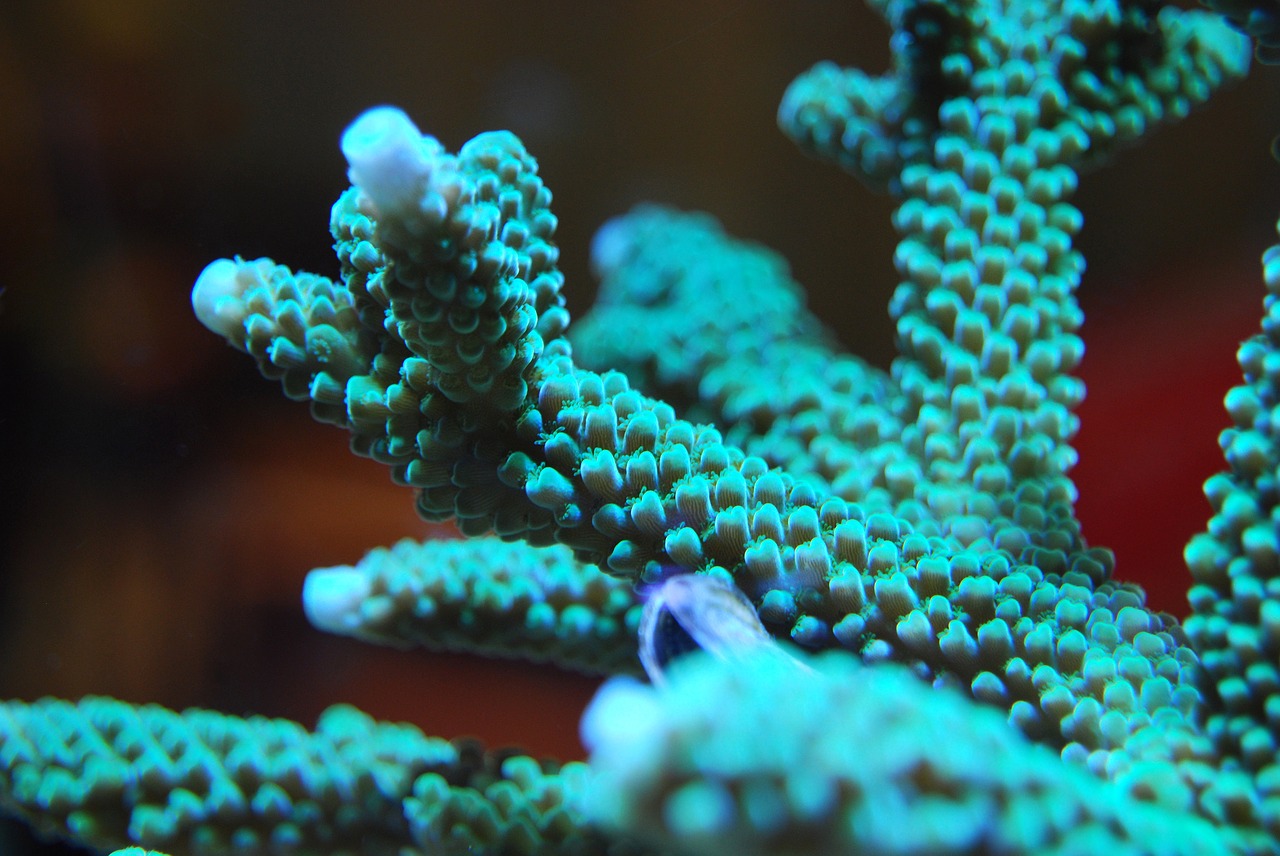
Closeup view of the small polyps of an Acropora coral.
For beginners, it is strongly advised to first gain experience keeping other corals such as LPS corals before trying your hand with SPS. This is due to the more stringent requirements and care needs they have. Once you have kept an LPS dominated tank successfully then an SPS dominated tank is the next step up.
When buying fragged corals it is always best to buy from a local supplier. A local supplier should frag their own corals, which means that the coral frag is already used to living and thriving in an aquarium environment. Make sure to ask where the coral frag is sourced!
Fragging SPS Coral
Fragging, or propagating, SPS coral is actually fairly easy and straightforward. When fragging LPS corals great care needs to be taken not to damage the large polyp, as they can easily get cut and get diseases. SPS corals have much smaller polyps and so this isn’t really a concern.
To frag an SPS coral, take a pair of bone cutters or a rotary tool and neatly cut the branch. There are two main methods of fragging these branching corals; snapping and sawing. These methods are exactly as they sound. You can either snap or saw the branch off. Both of these feel much like breaking a limb off a tree!
Once you have the frag, you can attach it to a small piece of rock or a frag plug using cyanoacrylate glue. The new frag can then be placed in the aquarium in the appropriate place.
Conclusion
Hopefully this guide to SPS coral has been helpful and informative. Keeping SPS corals successfully can be quite tricky, as they are quite susceptible to changes in water chemistry and temperature.
As such the water needs regular testing so that alkalinity, pH, calcium and magnesium concentrations, and nitrate, nitrite, ammonia, and phosphate concentrations all remain stable and in the correct ranges.
SPS corals are some of the most amazing looking corals, growing large in the tank and providing a brilliant environment for fish and invertebrates. Deciding to commit to an SPS dominant reef tank isn’t to be taken lightly, but will be very rewarding and produce amazing results!

